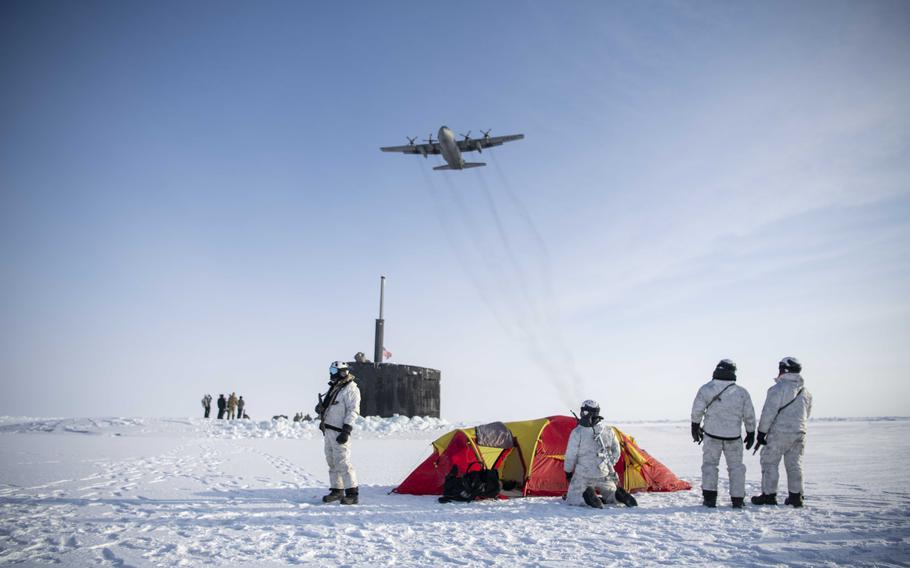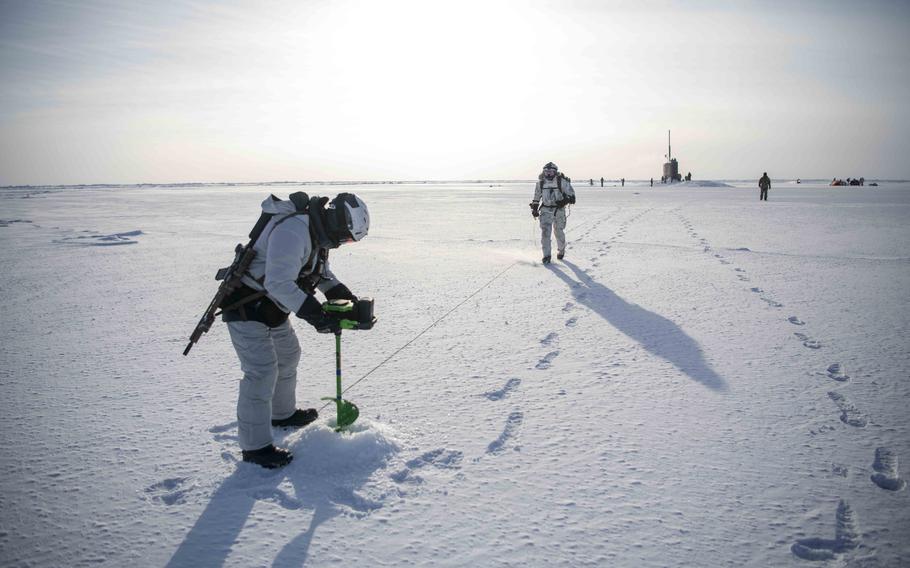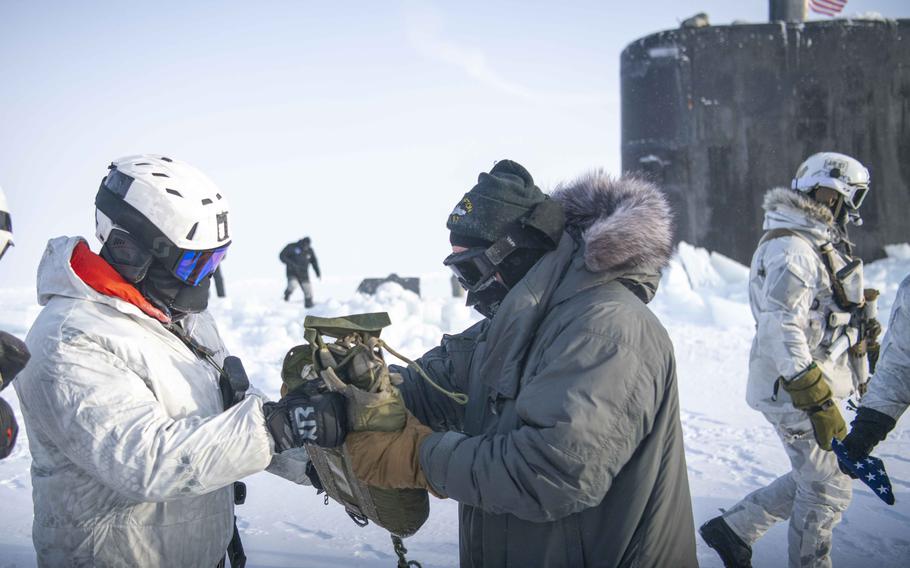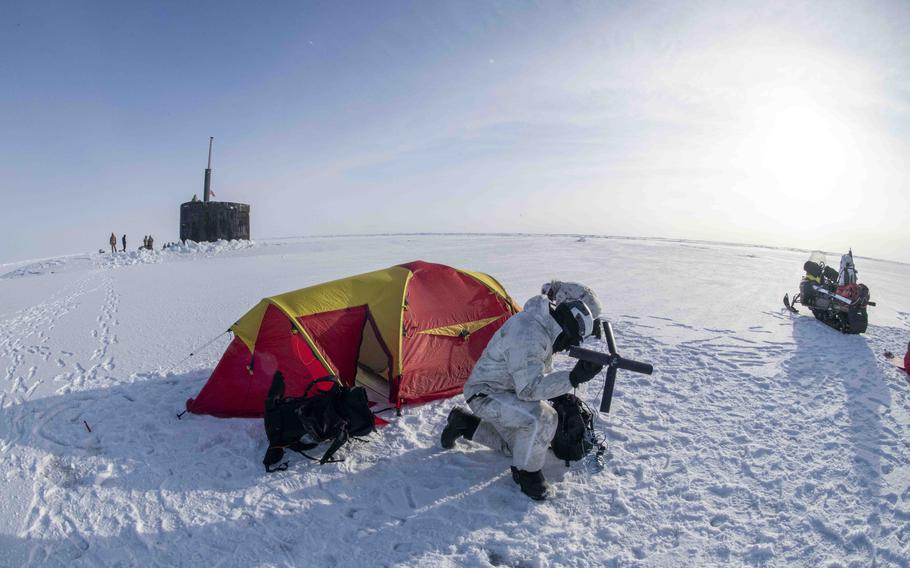
A C-130 Hercules assigned to the 109th Airlift Wing, part of the New York Air National Guard, flies over Navy SEALs, Norwegian naval special operations commandos and the attack submarine USS Hampton during an integration exercise in the Arctic Ocean, Saturday, March 9, 2024. (Jeff Atherton/U.S. Navy)
STUTTGART, Germany — U.S. special operators and allied commandos moved across frozen tundra in snowmobiles and linked up with a fast-attack submarine after it cracked through a thick sheet of ice, marking a first in the Arctic Circle, military officials said this week.
Some 400 Navy SEALs, Army Green Berets and elite troops from several NATO countries were fanned out in the upper Arctic for weeks to hone their cold-weather fighting skills during Arctic Edge 24.
The exercise was part of a flurry of ongoing military maneuvers stretching from the northernmost points of the United States to Finland, Sweden and Norway.
Special operators broke new ground when MH-47G Chinook helicopters landed in a secure zone past Utqiagvik, Alaska, having received ice depth information from a U.S. submarine in the area, Naval Special Warfare Group Two said in a statement Tuesday.

U.S. Navy SEALs and Norwegian naval special operations commandos test ice thickness to establish a landing zone for an MH-47G Chinook helicopter during an integration exercise in the Arctic Ocean on Saturday, March 9, 2024. (Jeff Atherton/U.S. Navy)
From there, the commandos took off in snowmobiles to set up a command-and-control tent, coordinated an airdrop “of a critical package” from a C-130 Hercules and carried on across the tundra to deliver the package to the submarine USS Hampton, which moments beforehand surfaced through the sea ice, military officials said.
“This marked the first-ever integration of SOF personnel, SOF aircraft and snowmobiles coming together to conduct an operation with a submarine that surfaced that deep in the Arctic Circle,” Naval Special Warfare Group Two said in a statement Tuesday.
Military officials did not detail the contents of the “critical package” or the nature of the training scenario, which brought together special operators and an attack submarine designed to seek and destroy enemy submarines and surface ships.
The strategic value of the High North has increased over the years, as melting sea ice opens the possibility of new shipping lanes and greater access to undersea natural resources that the Kremlin has its eye on. Russia has sought to fortify its position in the region with numerous military bases now in operation.

A Navy special warfare operator hands off a package from an airdrop to a sailor assigned to the attack submarine USS Hampton on Saturday, March 9, 2024, during an integration exercise that was part of Arctic Edge 24. (Jeff Atherton/U.S. Navy)
Capt. Bill Gallagher, commander of Naval Special Warfare Group Two, said in a statement Tuesday that the drills were intended to discourage aggression from potential adversaries.
“Given the frequency with which we are training alongside our allied partners and demonstrating our combined expertise in some of the most severe environments on the planet, we are sending a clear message about our warfighting ability and our preparedness to defend the homeland across the Arctic region,” Gallagher said in the statement.
Arctic Edge 24, which ended Tuesday, included special operators fast-roping from helicopters, multiple diving operations and pier-side vessel attacks by combat swimmer infiltration.

A Navy SEAL uses a radio on the ice next to the attack submarine USS Hampton during an integration exercise with Norwegian naval special operations commandos Saturday, March 9, 2024, as part of Arctic Edge. (Jeff Atherton/U.S. Navy)
Other exercises in the Arctic are ongoing. The two-week Nordic Response, which involves 20,000 U.S. and allied troops, will conclude Thursday.
Meanwhile, soldiers from the Alaska-based 11th Airborne Division will fly over the North Pole next week for Arctic Shock, which will see them dropping down in northern Norway.
“The Arctic is a critical region for power projection and homeland defense,” Maj. Gen. Brian Eifler, 11th Airborne Division commanding general, said in a statement Monday.